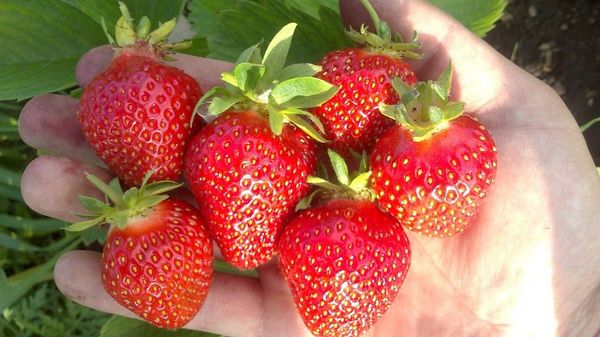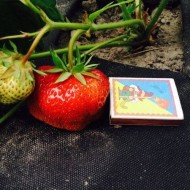Variety with ideal parameters or peculiarities of growing Clery strawberries
Content
Origin and recommended growing regions
Clery's strawberries are also often called garden strawberries. The berry appeared in sunny Italy thanks to breeders from the Matsoni Group company in the late 1990s. The "parents" Sweet Charlie and Vanbor were selected as the basis of the variety. The copyright for the variety is protected by a European patent.

Clery is best grown in a temperate continental climate, which is characterized by hot summers, frosty winters and little rainfall. In Italy, the variety is recommended for cultivation in the northern provinces. In Russia, the best option is the southern regions. You can grow a crop in other regions in a greenhouse (greenhouse or greenhouse).
Video "How to grow strawberries"
In this video, an expert will tell you how to grow large strawberries.
Botanical and varietal properties
Clery belongs to the early maturing varieties. But cold resistance and the ability to quickly adapt will pleasantly surprise gardeners.
Description of the plant
Clery belongs to remontant varieties, that is, the berry can re-bloom and bear fruit in one season. The berry begins to bloom in early May, and the first fruits appear towards the end of the month or early July. Bushes of the plant are tall and vigorous, with long sturdy petioles and large shiny dark green leaves.
A lot of peduncles are formed and they are quite thick. The flowers are lush and large, bright white with a prominent yellow center.
Taste and commercial qualities of berries
The fruits have a classic cone-like shape with a smooth blunt tip. The average weight of a berry is about 35 g, but some specimens can reach 50 g. Fruits are bright and shiny. The color changes: as they ripen, the fruits turn red, and when fully ripe, the berries acquire a dark cherry color.
A feature of the variety is the identity of the size of all berries. Specimens that do not correspond to the size of most fruits are extremely rare.
The structure of the pulp is very dense, but juicy, without internal voids, the grains are not felt when eating. The taste is sweet, without the usual sourness. It is thanks to this that the fruits receive the highest tasting marks. Strawberry aroma. Due to the characteristics of the bushes and berries, Clery is often called strawberries rather than garden strawberries.
Productivity
Clery's planting is designed for 4 years. It is during this period that the maximum degree of fruiting and all varietal characteristics are preserved.The yield is average - up to 290 c / ha. But regular fruiting, excellent presentation and uniformity of mass fully compensate for this.
Harvesting, storage and use
The fruits ripen almost at the same time, so it is convenient to pick them. The dense structure of the berries excludes the possibility of damage during picking, and also provides a high degree of transportability. The harvested crop can be stored in optimal conditions for up to 5 days.
The qualities of the Clery fruits allow them to be consumed both fresh and used for freezing. The dense structure ensures the integrity of the berry when preparing compotes and desserts. The high sugar content makes it possible to prepare jams, preserves and confitures with minimal consumption of granulated sugar.
Advantages and disadvantages of the variety
Reviews of gardeners and gardeners allow us to highlight the objective positive and negative qualities of the variety.
- unpretentious in care, perfectly tolerates cold and winter, as well as short-term drought without losses for the harvest;
- has good immunity to various diseases of the root system and mold resistance;
- excellent commercial characteristics of fruits: a high degree of transportability (berries do not crumple, do not expire with juice), shelf life up to 5 days, versatility of use;
- excellent composition and taste of berries: no acid (can be consumed by people suffering from gastrointestinal diseases), useful chemical composition (one of the best among strawberries), sweet taste and pleasant strawberry aroma;
- good productivity.
- low yield in the first year after planting;
- the need to replace the landing every 4 years;
- the rapid spread of infections;
- expensive planting material.
Planting and breeding methods
A healthy seedling does not guarantee success. Correct fit is equally important.

Determination of terms
The optimal period for planting Clery is early spring. As soon as the snow melts and the soil warms up a little, you can plant.
Bushes can also be planted from late August to mid-September.
Site and soil selection
For a garden bed, it is recommended to choose a flat or slightly sloping site on the southwest side. The southern side is not recommended - the snow melts too early, the plant may freeze slightly.
Almost any soil will do. The best options are black soil, forest soil, and medium loam. Too heavy or light soil requires the introduction of a large amount of organic matter. It is also not recommended to plant Clery in areas with a groundwater table close to the surface.
Propagating strawberries with a mustache
Clery bushes have a sufficient number of branches, whiskers. You need to choose the most productive bush, stretch out the shoot along its entire length and sprinkle it with fertile soil. After the appearance of leaves and independent roots, the antennae are separated from the outlet.
Reproduction by dividing the bush
For division, you need to take strong, overgrown three-year-old bushes. They are carefully dug in, get rid of the earthen coma and divided into parts so that each of them has several full-fledged roots. Then the parts are planted in the ground according to the standard scheme.
Cassette landing method
A fairly new, but very popular (especially among farmers) method of planting. The strongest antennae are cut off from strawberries, placed in a solution with a growth stimulator for 20 minutes, and then planted in special containers with soil - cassettes. They resemble ice-making containers in a refrigerator. The seedlings are then placed in greenhouses. In about a month, the bushes will be ready for planting.
Features of agricultural technology
Plant development, well-being and yield depend on proper care.Clery is unpretentious in her care, but there are procedures that cannot be avoided.
Watering, weeding and loosening
Water the bushes right at the root. Watering should be regular, but moderate, otherwise you can provoke the development of diseases. For large volumes, sprinkler irrigation is the best way to irrigate.
It is advisable to loosen the soil after each watering or at least once every two weeks. Weeding is carried out as needed. Wrapping or mulching the soil can save you this routine.
Top dressing and fertilization
Fertilizers are applied 4 times a year at different stages of the growing season. In early spring, complex fertilizers with a high mineral content are used. During the formation of inflorescences, phosphorus-potassium complexes are used. During flowering - organic. And towards the end of summer, complex fertilizers and ash are applied under the bush.

Pruning mustache and leaves
So that the berries do not become smaller, and the ordered bushes do not turn into jungles, you need to cut off multiple antennae in a timely manner. You also need to take care of removing old foliage.
In no case should young growth be removed.
Pest and disease control
Clery is resistant to most fungal infections. However, anthracnose can easily destroy all plantings, as the disease spreads very quickly. This can be avoided with the help of preventive treatment with copper-containing preparations. At the first signs of the disease, fungicides are used - "Antrakol" and "Ridomil".
A variety of slugs, ticks, aphids, weevils and May beetles threaten bushes. They fight pests with a decoction of tansy and a solution of laundry soap.
Reviews of gardeners about strawberry Clery
“I grow strawberries for sale. Clery is perfect. Although the harvest is not so much, the berries themselves are great: beautiful, uniform in size, shiny and sweet. What else does the buyer need? "
“Frankly speaking, this variety is not for everybody's taste. It is unpretentious in leaving. But the berries are too sugary-sweet. Not quite ripe, even crunchy, very hard. But that's what it is for desserts and compotes! "
Great appearance in the berry is not the main thing. But the harmonious combination of sweetness and sourness is important for many. If you are a sweet tooth and an esthete, then Clery is the perfect option for you.



